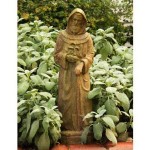 One of the popular ornaments in a garden is a statue of St. Fiacre, the patron saint of gardens. There are numerous portrayals of St. Fiacre and most show a humble man with a garden spade, sometimes with flowers, or a rabbit. The demeanor of the saint can add to the serenity of the garden and remind us of the long history of gardening. But, who is this man? Why is he associated with gardens?
One of the popular ornaments in a garden is a statue of St. Fiacre, the patron saint of gardens. There are numerous portrayals of St. Fiacre and most show a humble man with a garden spade, sometimes with flowers, or a rabbit. The demeanor of the saint can add to the serenity of the garden and remind us of the long history of gardening. But, who is this man? Why is he associated with gardens?
St. Fiacre was born in Ireland in the 7th century and went to France to live among the Franks as a missionary. In Meaux, an area close to Paris, he built a hospice with a cell for himself. The story goes that St. Fiacre obtained his land by a miracle. The Bishop of Meaux told him that he could have all the land he could plough in a single day. Using his staff, he marked out the area he wished to have and miraculously, a ditch was created and the trees, other vegetation and rocks within the area were uprooted. A woman who saw the miracle claimed it was witch craft and after that time St. Fiacre was said to have a dislike for women.
St. Fiacre was skilled in the growing and use of herbs and his hospice became a center for healing. Pilgrims flocked to his monastery with various ailments including “figs of Fiacre” (hemorrhoids), digestive problems, venereal disease, and urinary tract infections. St. Fiacre’s popularity continued long after his death in 670, after the French Revolution. He still continues to be popular in Ireland and France, however, where he is remembered with flowers, hymns, and parades on August 30.

If you would like to buy a St. Fiacre statue from Amazon.com click here.